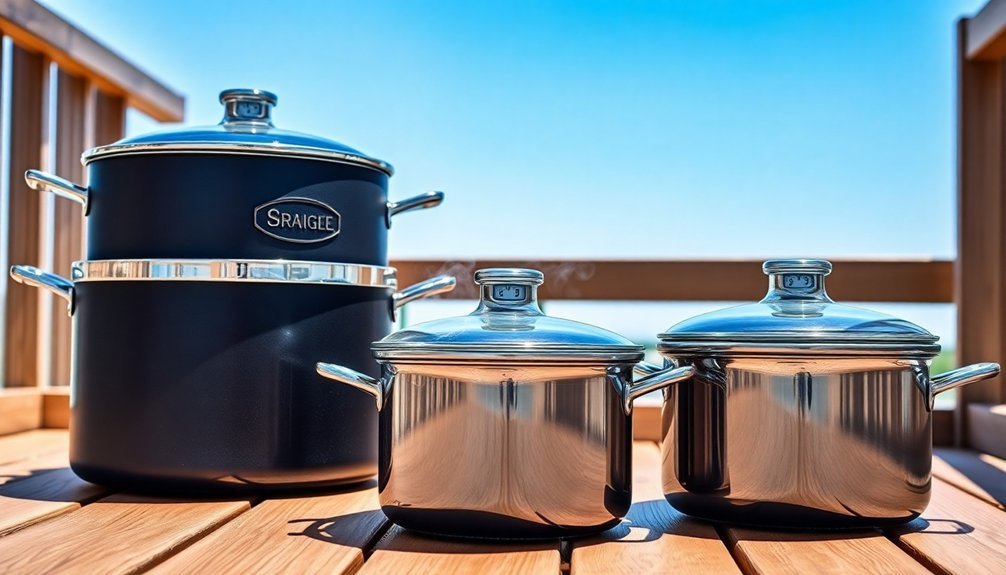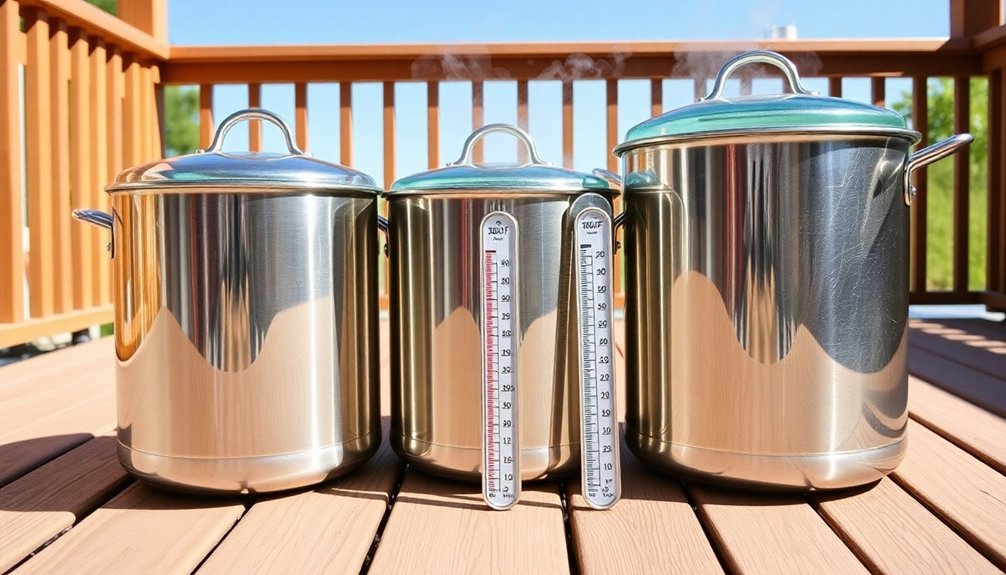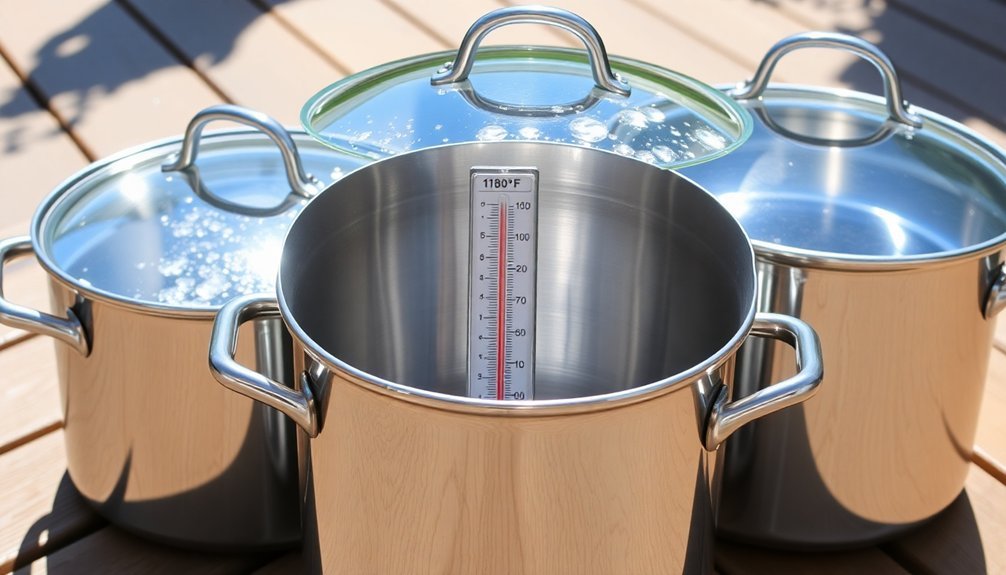The best stainless steel pots for sun cooking combine dark exteriors with superior heat retention. You'll want to take into account the Haines 2.0 SunUp Solar Cooker's 4.5-quart Dutch oven for its black coating and tempered glass lid. Multi-ply stainless steel pots with aluminum or copper cores distribute heat more evenly, while tight-fitting lids trap valuable warmth. Look for lightweight options with matte black finishes rather than reflective surfaces, and avoid heavy cast iron. The SolCook All Season model accommodates larger meals with its spacious 17-inch cooking area. Understanding the specific features of solar-optimized cookware will transform your outdoor cooking experience.
Top Solar Cooking Pots

Solar cooking enthusiasts have three standout options when it comes to high-performance pots.
The Haines 2.0 SunUp Solar Cooker features a 4.5-quart stainless steel Dutch oven with a black exterior and tempered glass lid, reaching temperatures up to 375°F. You'll appreciate its versatility for cooking pasta, rice, beans, and meats. Using a box cooker design, this model allows for multiple pots and racks to be used simultaneously.
For smaller portions, the GoSun Go Camp Stove uses an evacuated glass tube design that achieves impressive temperatures up to 550°F, though it's limited to 13.5 ounces of food.
If you're cooking for larger groups, the SolCook All Season Solar Cooker offers a spacious 17-by-17 inch cooking area that can accommodate a whole turkey and reaches 400°F. Its articulating panels help maximize sun exposure, though it doesn't include a thermometer or specialized baking trays.
Essential Features and Build Quality
When choosing cookware for solar cooking, material selection and build quality play essential roles in maximizing efficiency. You'll want to look for lightweight pots with matte black or dark-colored exteriors to absorb maximum sunlight. While stainless steel isn't typically ideal due to its reflective nature, you can opt for specially designed versions with black exterior coatings. For optimal solar energy absorption, the thermal mass conversion is critical to efficient cooking outcomes.
| Feature | Recommended | Not Recommended |
|---|---|---|
| Color | Matte black | Shiny, reflective |
| Weight | Lightweight | Heavy, cast iron |
| Material | Dark-coated steel | Polished aluminum |
| Accessories | Glass lids, bags | Metal lids |
For peak performance, ascertain your cookware includes insulation features like plastic oven bags or cooking sleeves. You'll also benefit from tempered glass lids that help retain heat while allowing you to monitor your food without disrupting the cooking process.
Performance Under Direct Sunlight

Three key factors determine how well stainless steel pots perform under direct sunlight: their color coating, heat absorption capacity, and insulation properties.
You'll get the best results with black-coated pots, as they maximize sunlight absorption. A smooth surface texture guarantees even heat distribution across your cookware. The pot's superior heat conductivity allows optimal sunlight-to-heat conversion during sun cooking.
To boost performance, look for pots with additional conductive layers like aluminum or copper. These materials enhance heat distribution while maintaining stainless steel's durability and non-reactive properties.
The pot's orientation matters too – you'll want to position it at a prime angle to capture maximum sunlight. For extended cooking sessions, consider using thicker-walled pots with higher thermal mass, as they'll retain heat longer.
Don't forget to use a tight-fitting lid to trap heat and create efficient convection circulation around your food.
Heat Retention and Distribution
Two fundamental properties define stainless steel pots' effectiveness in sun cooking: heat retention and distribution.
Due to stainless steel's high heat capacity and low emissivity, you'll find these pots hold heat longer than titanium alternatives, making them ideal for slow-cooking meals under the sun.
To maximize heat distribution, look for tri-ply or multi-ply construction with aluminum or copper cores.
You'll want fully-clad pots where this layering extends up the sides for even heating.
When sun cooking, place your ingredients in a circular pattern from the outside edge inward to maintain consistent temperatures.
Don't forget to use lids – they're essential for preventing heat loss.
While stainless steel may not heat as quickly as some materials, its superior heat retention makes it an excellent choice for solar cooking.
Durability and Long-Term Value

Stainless steel pots' remarkable durability complements their excellent heat retention properties, making them an outstanding choice for sun cooking enthusiasts.
You'll find these pots resist corrosion, scratches, and warping, even when exposed to prolonged sunlight and varying temperatures.
You won't need to replace your stainless steel pots frequently, as they're built to last a lifetime with proper care.
While they might cost more initially, you're investing in cookware that'll serve you reliably for years of sun cooking.
Maintaining their condition is straightforward – simply clean with mild soap and water, and occasionally polish with white vinegar or Bar Keepers Friend to restore shine.
These pots handle thermal stress well, making them perfect for sun cooking's gradual heating and cooling cycles without compromising their structural integrity.
Frequently Asked Questions
Can Stainless Steel Cookware Be Used With Other Alternative Energy Cooking Methods?
Yes, you can use stainless steel cookware with various alternative energy cooking methods. It's compatible with solar ovens, thermal cookers, and outdoor camping stoves. You'll find it works well with most eco-friendly cooking approaches.
What Cleaning Products Should Be Avoided When Maintaining Solar Cooking Pots?
You shouldn't use abrasive cleaners, metal scrubbing pads, or harsh chemicals on your cooking pots. They'll scratch the surface and damage the finish. Stick to mild soap and soft cloths for cleaning.
How Do Seasonal Changes Affect Cooking Times With Stainless Steel Pots?
You'll notice longer cooking times in colder seasons due to slower preheating. High humidity can extend cooking duration, while warmer temperatures speed up the process. Adjust your timing based on seasonal temperature variations.
Does Altitude Impact the Performance of Stainless Steel in Solar Cooking?
At higher altitudes, you'll find your stainless steel cookware performs better due to increased solar radiation intensity. The thinner atmosphere allows more direct sunlight to reach your pot, enhancing heat absorption and cooking efficiency.
Can These Pots Be Used for Food Storage After Solar Cooking?
Yes, you can safely store food in stainless steel pots after solar cooking. They're non-reactive and won't affect food taste or safety. Just make sure you clean and dry them thoroughly before storing leftovers.
In Summary
You'll find these stainless steel pots transformative for your solar cooking journey. Whether you're a seasoned sun chef or just starting out, investing in quality cookware optimized for solar use will enhance your outdoor cooking experience. Remember to take into account heat retention, durability, and even heat distribution when making your choice. With proper care, any of these top 5 picks will serve your solar cooking needs for years to come.





Leave a Reply